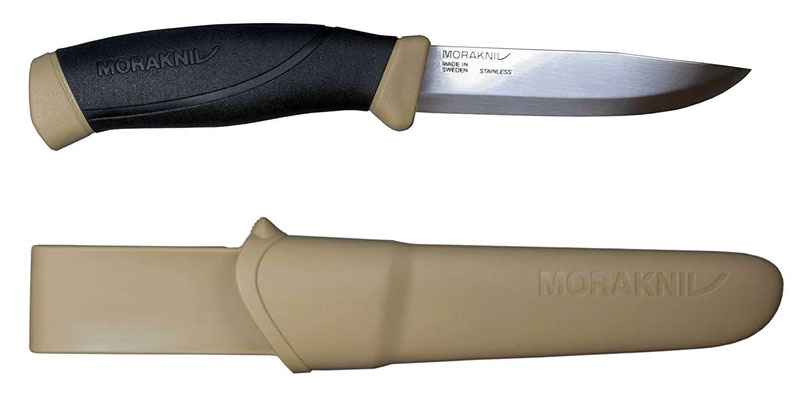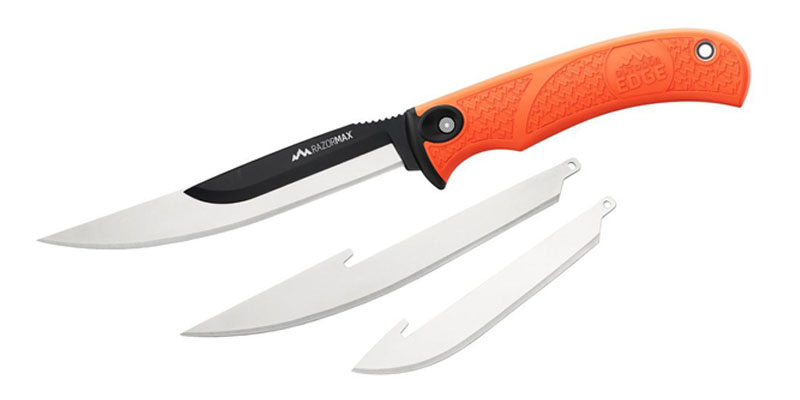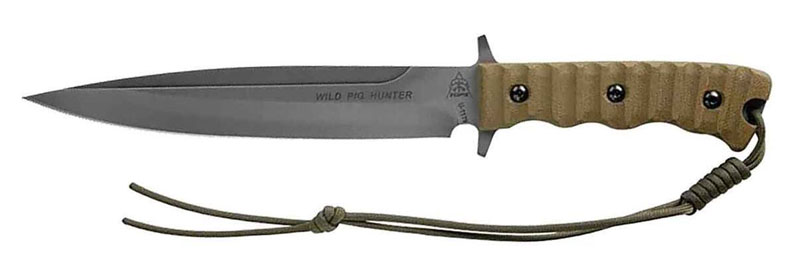Types of Camping Knives and Uses: A Complete Guide
By Trent Gander |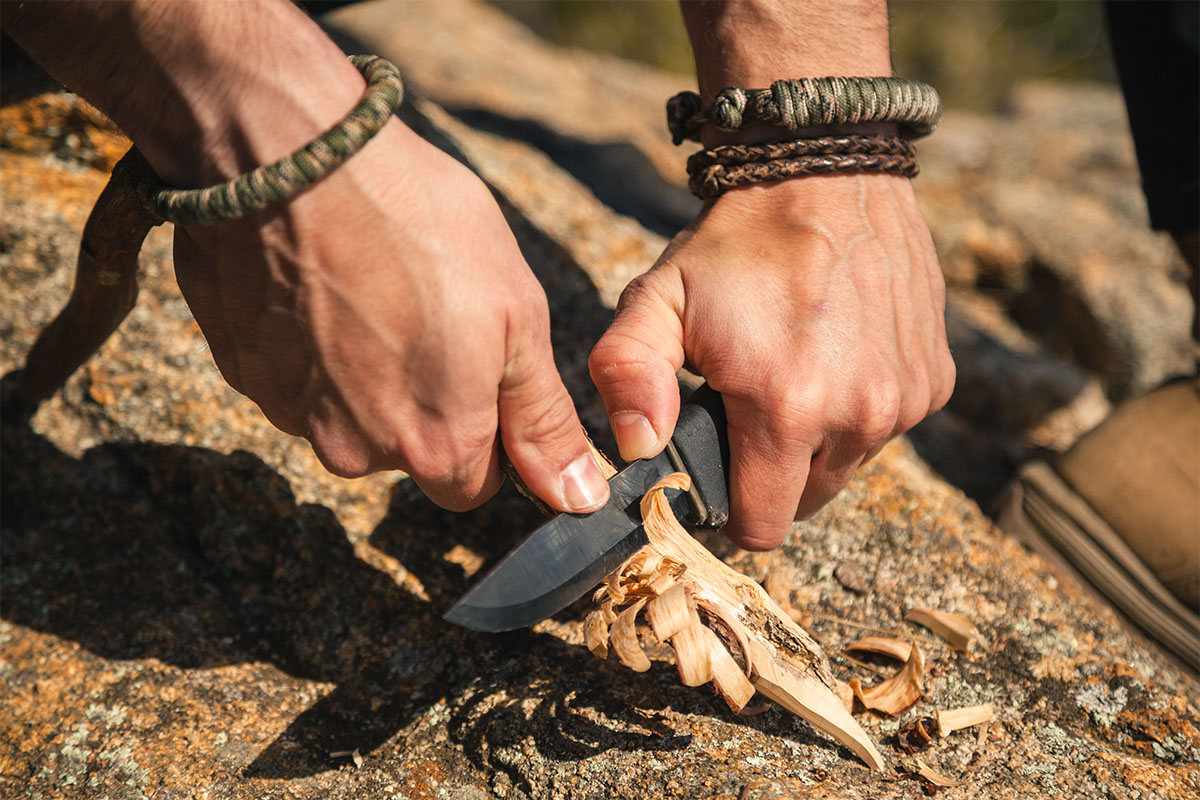
The world of knives is a complex place with many confusing options. There are so many different knife designs and styles that it’s hard to determine which knife suits your needs without a little experience.
Knives are some of the most versatile tools available today and a skilled end-user can take a knife and use it for almost any task.
However not all designs are as versatile as we need them to be. When it comes to camping knives we have a large number of choices and multiple tasks we need to consider when we select a knife to add to our equipment.
So let’s look into what goes into the various types of camping knives.
Camping Knives at a Glance
There are three major types of camping knives. Camp knives, hunting knives, and survival knives. Camp knives are geared towards general utility while hunting knives deal with processing or killing game. Survival knives try to bridge the gap between camp and hunting knives.
While we now have a general idea of what camping knives do, we need to fully understand which tasks each style is likely to encounter. This will help us select the correct knife easily so we don’t waste money on something we might not need.
Camping, Hunting, and Survival Knives
The knives that fall under the categories of camping, hunting, and survival are not set in stone. Some designs fall under multiple definitions and different people will categorize knives differently.
This means the intended use of the knife gives us a better definition than the overall design. Multiple designs can fit the same role, but some designs are made in such a way that it’s unlikely for them to fit multiple roles.
So this brings us to the main question.
What’s the Difference?
The differences between these types of knives comes down to what they are likely to do while we’re out in the field. So let’s define what these major categories are in order to get a better idea of the knives that fall under these definitions.
Camping/Camp
Camping or camp knives are those knives that are geared towards general utility. They are used to make camp and this can include cutting materials, shaping wood, or even preparing food.
This means that the blade shape should be generalized. Knives of this type tend to have decent bellies on the blade (the curve from the blade’s tip to the main edge of the blade). This allows for better cutting and slicing than those blades with smaller bellies.
The improved cutting and slicing comes from the ability to put a smaller angle of the blade against what you are cutting for a longer duration as you pull the edge across it.
This means drop point blades or straight back blades are more likely to fall under camp knives than than other blade types.
However not all camp knives are like this, some are supplementary blades like small folding knives. Either way, a camp knife is more focused on the general tasks of preparing a good campsite for you to stay in than processing game.
Because they need to be a more convenient tool, camp knives can range from 3 inches in the blade all the way to 10 inches with most maxing out at 5 inches. The larger 10 inch blades tend to be things like heavy duty machetes or other blade types that are going to be used on branches or saplings.
Most camping knives are similar to the Morakniv brand of blades. Small 4-5 inch blades designed with very simplistic edge styles to allow for the most versatility.
Hunting
Hunting knives can be very different from camp knives. This is because they are more specialized in the tasks they need to perform.
For the most part hunting knives are directly related to game. This creates two different designs of hunting knives: game processing and game killing or animal use.
Game Processing
Game processing takes place after the hunt. The animal is dead and if we intend to eat parts of it we have to bleed it, skin it, and take it apart.
This is mostly done with knives designed specifically for in-field butchering. These types of blades are usually one of many blades brought for the process of butchering an animal.
Blades like skinning knives/skinners or more complex knife blades are designed to help remove skin and guts easily without a lot of damage to the meat.
Because this can be a very low impact process you will find some game processing knives are foldable and have interchangeable blades. This is because cutting meat and separating the meat from the bone can dull knives quickly.
Some hunters prefer to continually sharpen their game knife while processing the animal but this takes time and is very inconvenient if you only have a limited amount of light to work with. It is much easier to swap out to a fresh, sharp blade and continue processing the meat so you can get back to camp or home sooner.
These types of hunting knives are the dry land equivalent to filet knives in fishing. Something that will allow you to quickly process the game and make it ready for storage or eating quickly.
Game Killing/Animal Use
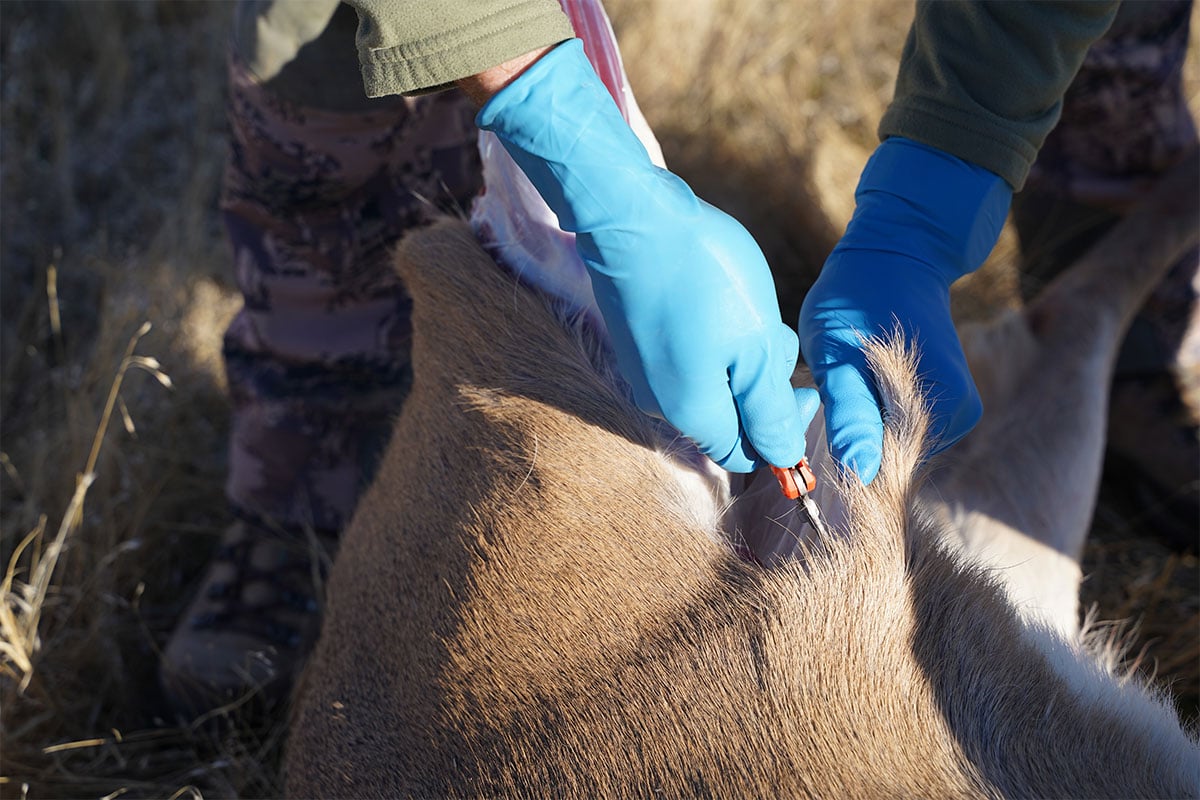
This is where hunting knives can differ the most from camp knives. Some hunters prefer to hunt things like boar with dogs or older methods of hunting. This generally ends with the hunter using a knife to kill the animal.
This can be very rewarding and very dangerous at the same time. Because of this, knives used specifically to kill animals look very similar to large fighting knives.
These types of blades are exclusively fixed blades. The reason for this is the needed durability required for stabbing a boar or similar animal. Folding knives are less solid than a continuous piece of steel. Combined with the larger blade lengths that these types of hunting knives have and you have the potential of exerting a lot of force on a knife.
If you were using a folding knife for this, all the force would go from the blade to the folding mechanism. Which would increase the likelihood of the knife snapping in half. This is not ideal, so a fixed blade is the better option.
Additionally these types of hunting knives are more thrust-centric or designed for stabbing. This is because stabbing allows you to reach the heart, major organs, or major blood vessels more easily than a cut.
This is one of the reasons we use high penetrating bullets or broad head arrows to shoot game rather than stab it. It’s easier to reach the internal organs with more modern techniques than it is to stab them.
Because of the violent nature of using a knife to kill an animal, hunting knives of this type will have blades 6-10 inches long with wider blades that narrow to a piercing point. The blade width helps in creating a wound channel which in turn leads to a more ethical kill.
These knives will also feature things like handguards and heavily textured grips to help keep your hand on the grip without slipping in addition to helping with the extraction of the blade.
A good example of this type of knife is the TOPS Knives Wild Pig Hunter.
Survival
Survival knives attempt to roll the camp knife and the hunting/fighting knife into one item. Many survival knives today are actually variations of the camp knife with some fighting ability.
However many people think of the “Rambo knife” when they hear “survival knife”. This is characterized by a knife with a hollow handle filled with a small survival kit. The blades of these types of knives tend to be more complex with multiple edge styles or rear-facing serrations.
These blade styles attempt to provide the end user with a tool that can be used as many different tools. However a lot of the more common renditions of these types of knives are very low quality.
A good survival knife needs to be durable and not just a wall hanger. This means that survival knives either will be slightly modified camp knives or more expensive “Rambo-esque” blades.
Since they are trying to fill multiple roles, survival knives will tend to be 4-7 inches in the blade. There are smaller and longer blade lengths for survival knives, but most will fall in that blade range.
Simple blade designs are better for survival knives but we’ll cover those in more detail later. A good example of a practical survival knife with a more complex blade is the Smith & Wesson Ultimate Survival.
Knife Designs
Knife design is one of the major discussions that occur in the knife world. The problem with this is that a lot of the disagreements on specific designs come down to personal preference. Many blades are very good knives but because someone doesn’t like the shape of the blade or the maker, there is a problem.
For camping and hunting knives this is a little easier as most of the styles have solidified on a number of design features that are dependent on your use.
So let’s look at some of the major design considerations for selecting a camping/hunting knife.
Fixed or Folding?
| Fixed Blade Knives | Folding Blade Knives |
|---|---|
|
|
| Note: Keep in mind that this table is based on generalizations and there may be exceptions to these points based on specific knives. | |
There are two major designs that we can consider: Fixed blade knives or folding knives.
Each has their own benefits and drawbacks, but they are not 100% interchangeable depending on the task we need them to perform.
Starting with folding knives, we have a very convenient knife design. There’s little to no need for a sheath as most folding knives today feature some form of pocket clip. This means we can easily carry them whenever and wherever we need to.
However many common folding knife designs are not as durable as fixed blade designs. Some versions are over-built in order to be more durable, but it takes more effort to make a folding knife extremely durable. This results in very expensive folding knives that can take a beating but will also drain your wallet.
This means folding knives are better suited for either game processing or light camp chores like cutting cordage or preparing twigs for firing making. They can also be used while cooking, but harder use is not recommended.
This brings us to fixed blade options. Fix blade knives have been around for a long time and are some of the most refined blade styles available.
They tend to be more durable than folding knives since the blade and handle are designed not to move, depending on the design. This strength comes from one of two places.
The first option is that the blade has a long tang. This means the blade extends into the handle for a certain length and creates continuity with the blade. Full tangs or tangs that extend through the entire handle can be extremely strong. But that does not mean partial tang knives are easy to break.
Partial tang knives bring us to the second option for fixed blade durability, how well the handle is fit to the blade.
Many camp knives and survival knives feature partial tangs. Those that have hollow handles and Morakniv brand knives are good examples. Quality versions can be heavily used like full tang knives and do not break under normal circumstances.
This comes from the design of the handle. Some handles will reinforce the tang of the blade making the overall knife stronger. Many times full tang blades will just have “handle scales” on the side of the tang. These scales add grip to the knife but don’t necessarily reinforce the handle.
Some knives feature skeletonized grips and have no additional reinforcement at all. These types of knives are better for general use than heavy duty tasks. They are essentially the fixed blade equivalent for a folding knife.
Fixed blades have the drawback of requiring a sheath to store them properly. The entire length of the knife has to be accommodated which means they take up more room than a folding knife. But they are easier to deploy than a folding knife, all you have to do is draw it out of the sheath.
The size of some hunting knives can be particularly problematic. Blades that are 7 inches long tend to be around a foot long overall or close to it.
This means anything larger than a KA-BAR Fighting/Utility knife is going to take up more real estate on your person and gear than a knife with a 4 inch blade. This can make them harder to deploy and limit where you can carry them.
Now let’s look at the blades these knives provide us with.
Blade Shape
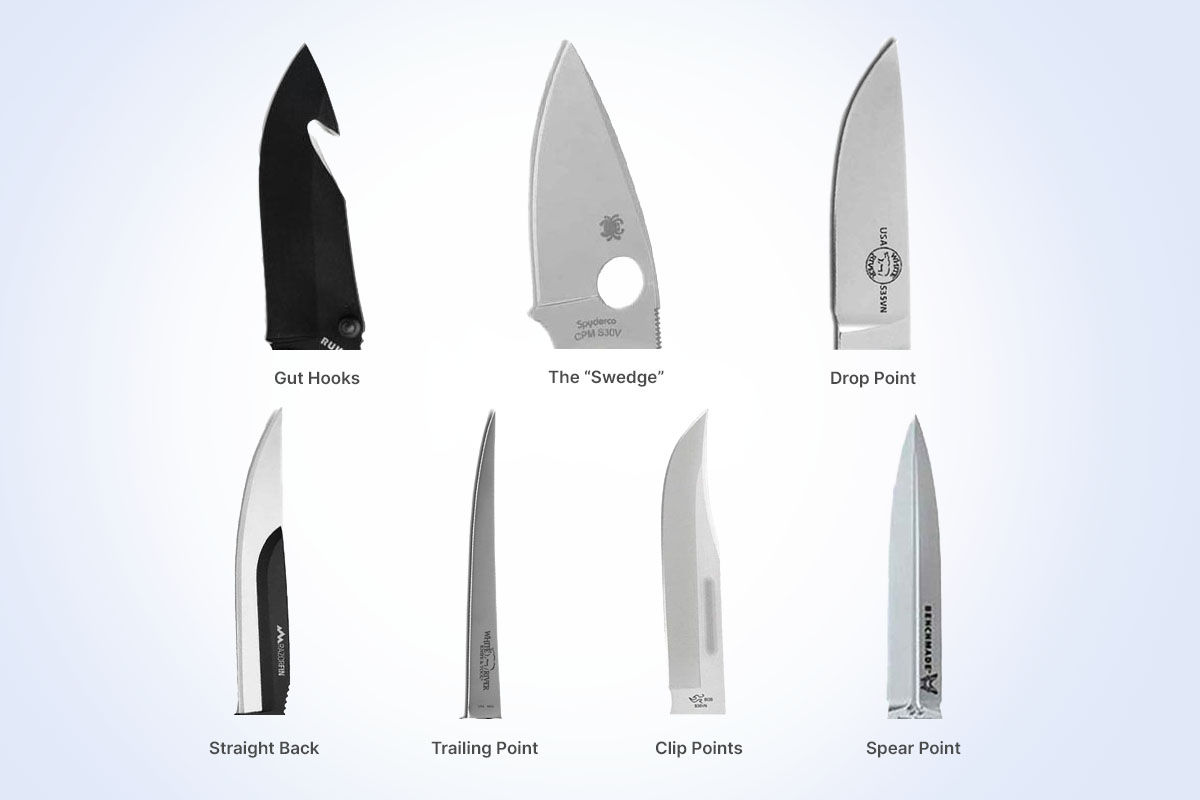
The shape of a blade can tell us a lot about what we can do with the knife itself. These can be small additions to the blade or the overall blade design.
We’re going to look at two blade features and several blade shapes that are more common on camping knives.
Gut Hooks
Gut hooks are specialty additions to knives. They are small areas on the blade of a knife that feature a recessed edge.
They are designed to make gutting animals easier by limiting how deep the blade can go. Gutting animals can be done with a regular blade, but if you are not as experienced with blade control you run the risk of piercing the intestines and contaminating the meat.
One of the ways to avoid this is to use a blade with a gut hook. It works very similarly to a seatbelt cutter but instead of a seatbelt it’s the skin and muscle on the abdomen and chest cavity of the game.
Gut hooks can speed up part of the after hunt processing, but are not a 100% required blade feature. They are found almost exclusively on hunting knives used for processing animals.
The “Swedge”
The “Swedge” is a nuanced part of the blade. In practice it is a narrowing of the blade on the spine. This is normally near the tip when the blade is either going down to the point or it can be along the entire length of the blade.
The “Swedge” is not sharp but it can aid in piercing material like a secondary edge would. This is why it is found on both camp knives and hunting knives. It adds some versatility to the blade while increasing any penetration performance the knife might have.
Drop Point
Drop point blades feature the point of the blade lower than the spine of the blade. These types of blades generally have good blade bellies with a usable point.
Since the back or spine of the blade “drops” to a point they are referred to as “drop point” blades. This adds a number of benefits to the blades overall use.
The blade can be more easily choked-up on because of the slight drop in the spine. This means you’ll be able to do more fine-tuned work like drilling/reaming or shaving material. This lends it to the general use of a camp knife which is why many camp knife designs are some variation of drop point.
Straight Back
Straight back blades do not feature a drop in the spine. This makes them visually similar to common steak knives.
When compared to drop point knives these blades have better penetration ability while maintaining good slicing utility.
Straight back blades tend to have narrower bellies with longer belly sections than drop point blades. This means they have to be longer to get similar cutting performance. This doesn’t matter as much if they are being used exclusively for processing game.
Since straight back blades tend to be narrower overall they can fit into the nooks and crannies of a carcass better than wider profile blades.
Trailing Point
Trailing point knives place the point of the blade behind the initial spine of the blade. The tip “trails behind” the spine’s starting angle creating a longer belly.
These types of knives are better for long slicing motions than other designs. This means they make great carving knives and can process meat easily. While they can offer a good amount of utility, they shine the best as processing knives.
Clip Points
Clip points are almost a hybrid between a drop point and a trailing point. These types of knives offer aggressive piercing potential while allowing for good cutting ability.
Many early hunting knives feature this type of point as do more famous knife styles like the bowie knife.
The clip point can be featured on any length of blade, however they tend to be found on longer 6-10 inch blades. This makes them good for taking down game and some light processing jobs.
Clip points can be very curved. Some clips are almost “C” shaped and are referred to as California clips. These offer better cutting with slightly less piercing ability. Other clips that are longer and narrower are referred to as Turkish clips.
Both offer a good mix between utility and fighting, which makes them great for taking down dangerous game.
Spear Points
Spear points are some of the most thrust-centric designs. Trying to use them for utility is a waste of their specialized design.
Can they be used to cut material and make camp? Yes. Will they be particularly good at it? No.
These types of blades are best suited for hunting boar and other animals if the knife has a long enough blade.
Conclusion
Camping knives cover a broad section of the outdoor world. Selecting the right one can make your time in the field easier.
If you just want a knife that takes care of everything related to building and maintaining camp, then a good drop point knife is in your future.
If you need something for your next boar hunt, a fixed blade with a spear or clip point and a good handle will be perfect.
Knife selection comes down to personal preference. Once you understand the limitations of the blade’s shape and design you can then make a good choice for your needs.
